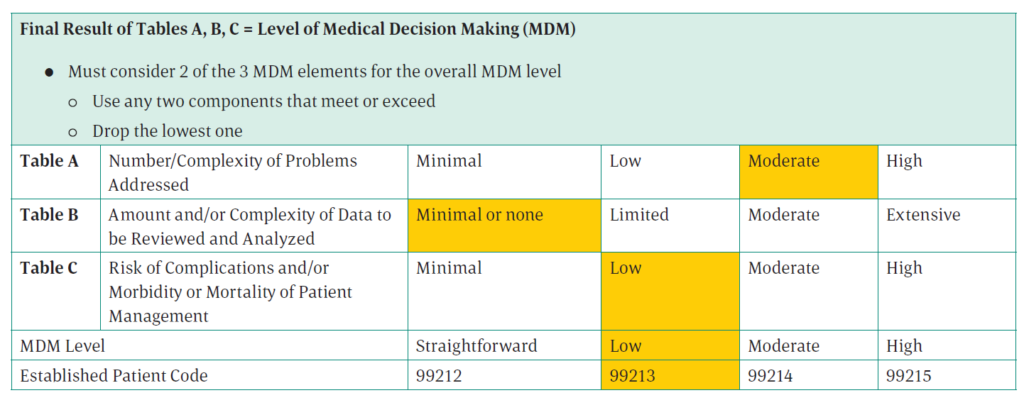Chapter 19: CPT Evaluation & Management Section Workbook Case 10 Answers and Rationale.
Established Patient
Chief Complaint: Thoracic spine pain |1|
Problem List:
1. Rheumatoid arthritis, right and left hands.
2. Compression fracture of the thoracic spine T11.
3. Alcoholism.
4. Depression/anxiety.
Review of Systems: His pain is significantly improved in his thoracic spine. He does have low back pain. He has a history of chronic low back pain. He is still wearing a thoracic support brace. He is going to follow up with Dr. X’s office in about six weeks or so. Since I have seen him last, he had a small flare of arthritis after his Humira injection. This resolved after 2-3 days. He had pain and stiffness in his hands. Currently he denies any pain and stiffness in his hands. He has one cystic mass on his left hand, second distal pad that is bothersome.
Current Medications: Vasotec 20 mg a day, Folic Acid 1mg a day, Norvasc 5 mg a day, Pravachol 40 mg a day, Plaquenil 400 mg a day, Humira 40 mg every other week, Celexa 20 mg, a day, Klonopin .5 mg as needed, aspirin 81 mg a day, Ambien 10 mg as needed, Hydrocodone as needed.
Physical Exam: He is alert and oriented in no distress. Gait is unimpaired. He is wearing the thoracic brace. Spine ROM is not assessed. Lungs: Clear. Heart: Rate and rhythm are regular.
Musculoskeletal Exam: There is generalized swelling of the finger joints without any significant synovitis or tenderness. There is a cystic mass on the pad of his second left finger, which is tender. Remaining joints are without tenderness or synovitis.
Review of DEXA (Dual Energy X-ray Absorptiometry) Scan: |2| (Performed in office today) There is low bone density with a total T-score of -1.1 of the lumbar spine. Compared to previous it was -0.8. There has been a reduction by 3.6%. T-score of the left femoral neck -1.1, Ward’s triangle -2.4, and total T-score is -0.8 compared to previous there has been a 7% reduction from last year.
Assessment:
1. Seronegative rheumatoid arthritis in both hands. |3 | He is doing fairly well. He does have a cystic mass, which seems to be a synovial cyst |4| of the left second digit. He was wondering if he could have this aspirated.
2. Senile osteoporosis and continued care for compression pathologic fracture. |5| He is being treated for osteoporosis because of this. He is tolerating Fosamax well. He is also using Miacalcin nasal spray temporarily to help and it has been effective.
Plan:
1. Continue current therapy.
2. Aspirate the synovial cyst in the left second finger. |6|
3. Follow up in about 6-8 weeks.
4. Repeat labs prior to visit.
Procedure Note: |7| With sterile technique and Betadine prep, the radial side of the second finger |8| is anesthetized with 1 cc 1% Lidocaine for a distal finger block. Then the synovial cyst is punctured and material was expressed under the skin. |9| I injected it with 20 mg of Depo-Medrol. 10| He will keep it clean and dry. If it has any signs or symptoms of infection, he will let me know.
|1| Chief complaint.
|2| DXA of the spine. This is reported separately with 77080 so the review is not taken into consideration for the MDM.
|3| Primary diagnosis. This is a chronic condition which is stable.
|4| The diagnosis for the aspiration procedure. This is an acute uncomplicated problem.
|5| Additional diagnoses which are chronic, stable conditions.
|6| The decision to aspirate the cyst is after a full workup.
|7| Minor procedure with no additional identified risk factors for this patient.
|8| Modifier F1 is appended to indicate the second finger.
|9| Aspiration of the joint.
|10| Injection of the joint.
What are the CPT® and ICD-10-CM code(s) reported?
CPT® codes: 99213-25, 20612-F1, 77080, J1020
ICD-10-CM codes: M06.041, M06.042, M71.342, M80.08XD
Rationale:
CPT® codes: Subcategory — Office visit, established patient, coded using 2021 E/M guidelines
Number and complexity of problems addressed: One acute problem and two stable chronic illnesses, making this moderate for the number and complexity of problems addressed.
Amount and complexity of data to be reviewed and analyzed: The provider ordered and performed a DXA scan. The scan was reported with a separate CPT® code so no credit is given towards the MDM.
Risk of complications and morbidity or mortality of patient management: The patient has a minor surgery with no identified risk factors, making the risk level low.

During the office visit, a DXA scan of the spine (axial skeleton) was performed. In the CPT® Index, look for Dual X-ray Absorptiometry (DXA)/Axial Skeleton and you are directed to 77080.
There was also a decision to aspirate the synovial cyst on the second finger. Look in the CPT® Index for Synovial/Cyst – See Ganglion; Ganglion/Cyst/Aspiration/Injection referring you to code 20612. Modifier 25 is appended to the office visit to indicate it is separately identifiable from the procedure. Depo-Medrol was injected. Look in the HCPCS Table of Drugs for Depo-Medrol and you are directed to see Methylprednisolone Acetate. Methylprednisolone Acetate, 20 mg directs you to J1020. J1020 reports Depo-Medrol, 20 mg.
ICD-10-CM codes: Seronegative rheumatoid arthritis is the first listed diagnosis in the assessment.
In the ICD-10-CM Alphabetic Index, look for Arthritis/rheumatoid/seronegative/hand joint referring you to M06.04-. The Tabular List provides two codes to report this condition in both hands: M06.041 and M06.042. The second diagnosis is for the synovial cyst that was identified and a procedure was performed. In the Alphabetic Index, look for Cyst/synovial referring you to – see also Cyst, bursa. In the Alphabetic Index, look for Cyst/bursa, bursal NEC/hand referring you to M71.34-. Complete the code in the Tabular List, the cyst is on the left hand, reporting M71.342. The next diagnosis to report is osteoporosis. In the Alphabetic Index, look for Osteoporosis/senile- see Osteoporosis, age-related. Look for Osteoporosis/ age-related/with current pathologic fracture/vertebra referring you to M80.08-. In the Tabular List, a 6th character X is
reported. The 7th character D is reported because this is not the initial encounter for the compression fracture and the assessment mentions continued care, indicating aftercare. The correct code is M80.08XD.
